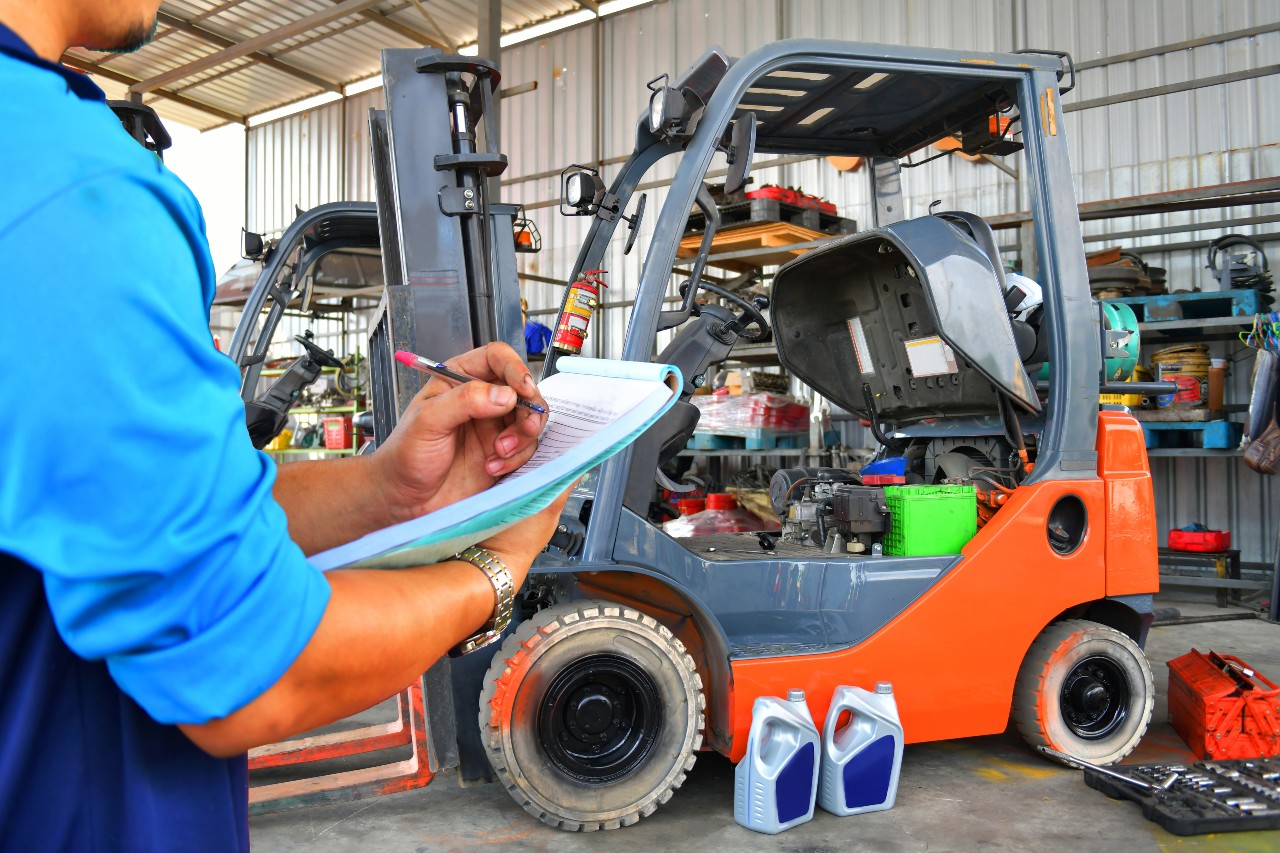Forklifts need regular care to stay safe and efficient. Every 200-250 hours or six weeks, they should get a full check-up and service. Before starting work each day, forklifts should undergo a quick inspection to make sure everything’s in order. Good maintenance not only keeps your forklift running smoothly but also prevents accidents. That’s why the Occupational Safety and Health Administration (OSHA) can fine companies that don’t take proper care of their forklifts.
If forklifts aren’t looked after, small problems can turn into major, expensive ones that take a long time to fix. Neglected forklifts can be dangerous for operators, other workers, and nearby equipment and personnel; every year, there are about 85 deaths and 34,900 accidents involving forklifts. While some accidents happen because of a lack of training, many others are caused by poor maintenance. This is why forklift maintenance is crucial and why it should be practiced everywhere.
What is Forklift Maintenance?
Forklift maintenance involves regular checks and servicing to ensure forklifts remain safe and operational. This process helps avoid breakdowns, extends the forklift’s lifespan, and reduces the risk of accidents.
There are two key types of maintenance: daily inspections by operators to spot any issues, and scheduled servicing by trained technicians to handle wear and tear, replace fluids, and make necessary adjustments. Both types are essential for maintaining the smooth and safe operation of your forklift.
Importance of Forklift Maintenance
Regularly looking after forklifts is important for a few reasons:
- Saving Money: Planning maintenance helps cut costs, including expensive production downtime. Some managers say every minute a forklift is down costs a lot of money. Plus, keeping up with maintenance helps avoid fines from safety regulators.
- Making Them Last: Well-looked-after forklifts stick around for a long time, doing their job safely and reliably.
- Getting More Done: Regular maintenance means fewer surprise breakdowns and less time when your forklifts aren’t working. That means more work gets done in the same amount of time.
- Getting a Good Deal: When it’s time to sell, a forklift that’s been well-maintained can fetch a better price because buyers trust it to work well.
- Staying Safe: Most importantly, looking after your forklifts means safer working conditions. It helps prevent accidents caused by equipment breaking down unexpectedly.
How Do You Maintain A Forklift? OSHA Forklift Maintenance Requirements
According to OSHA regulations, forklift operators must conduct additional checks depending on whether their forklift is powered by electricity, internal combustion, or liquid propane. Here are the daily inspection items for each type:
Electric Forklifts:
- Check cables and connectors
- Ensure battery restraints are secure
- Check electrolyte levels
- Ensure the hood latch works properly
Internal Combustion Forklifts:
- Check engine oil levels
- Inspect the brake reservoir
- Check engine coolant levels
- Inspect the air filter
- Check belts and hoses
- Ensure the radiator is in good condition
- Check the hood latch
Liquid Propane Forklifts:
- Ensure the propane tank is secure
- Check the pressure relief valve
- Inspect hoses and connectors
- Check tank restraint brackets
- Inspect the tank for dents or cracks
- Check for any leaks
How Often Should Operators Inspect Their Forklift?
Each forklift part needs servicing between 200 and 2,000 hours, depending on the part and the device’s quality.
Daily checks are necessary for safety features like alarms, while some internal parts only need maintenance every few months. To figure out how often forklifts need repairs, consider these factors:
- Age: Older forklifts, like those that are five or more years old, need more frequent checks than newer ones.
- Service History: Pay extra attention to parts that have broken down repeatedly.
- Work Environment: Forklifts in tougher jobs, like moving raw materials on rough terrain, need more care than those working in a warehouse.
- Maintenance Standards: OSHA sets minimum maintenance requirements, but many teams choose to exceed these for added safety.
Forklift Maintenance Checklist
Daily Forklift Check
- Look Around: Check the forklift for any damage, leaks, or loose parts. Look at the mast to see if it’s bent or out of place. Make sure the tires are okay.
- Fluid Check: Look at the engine oil, transmission fluid, brake fluid, and hydraulic fluid. Top them up if needed, following the instructions.
- Battery Check: Make sure the battery terminals are clean and tight. Check if the battery is charging okay and if it’s working properly.
- Brake Check: Test both the parking brake and the service brakes. Listen for any strange noises when you use them.
- Lights and Horn: Try out all the lights and the horn to see if they’re working.
- Steering: Turn the steering wheel both ways to make sure it moves smoothly. Look for any leaks around the steering parts.
- Forks and Attachments: Measure the height of the forks and check if they’re even. Look at the carriage and mast for any damage.
- Seat and Seatbelt: Adjust the seat for comfort and make sure the seatbelt works.
- Controls and Gauges: Check all the buttons and gauges to make sure they’re working. Look for any warning lights.
- Load Capacity Plate: Check that the plate showing how much the forklift can lift is in the right place and easy to read.
- Attachments and Accessories: Make sure any extra bits added to the forklift are securely attached and working right.
- Emergency Stop Button: Press the emergency stop button to see if it works quickly. Make sure it’s easy to reach.
Remember: If you find any problems during the check, tell your boss or the maintenance team straight away. Don’t use the forklift if there are safety issues.
Weekly Forklift Check
- Look Around: Check the whole forklift for any loose parts. Pay extra attention to the overhead guard.
- Fluid Check: Look under the forklift for any leaks. Make sure all the fluid levels are okay.
- Battery Check: Check the battery terminals again and see if the battery is charging right.
- Brake Check: Test the emergency brake and listen for any strange sounds when you use the brakes.
- Lights and Horns: Clean the lights and replace any broken bits. Check all the lights again.
- Steering: Look for any problems with the steering wheel and check for leaks.
- Forks and Attachments: Measure the forks again and look for any damage.
Monthly Forklift Check
- Hydraulic System: Check the hoses for any damage and make sure the mast moves smoothly.
- Cables and Chains: Oil the chains and cables and check if they’re tight and straight.
- Exhaust System: Look at the exhaust bits for cracks or rust. Check if the emissions are okay.
- Load Backrest Extension: Make sure the backrest is on properly and not damaged.
- Governor and Accelerator: Check if the speed control is set right and if the pedal works smoothly.
- Seat and Seatbelt: Adjust the seat again and see if the seatbelt is still good.
Annual Forklift Check
- Professional Check: Get a pro to check the forklift properly. Fix anything they say needs doing.
- Load Test: Test how much the forklift can lift safely and keep a record of it.
- Overhead Guard: Check the guard for any problems and make sure it’s safe.
- Forklift Tires: Look at the tires for any damage and make sure they have good grip.
- Brake System Overhaul: Take the brakes apart and check them carefully. Replace anything that’s worn out.
- Frame and Chassis Check: Look over the whole forklift to see if there are any weak spots or rust.
Streamline Forklift Maintenance with NEXGEN
Forklifts are a big investment for businesses, but if you follow the tips and guidelines we outlined above, your forklifts will stay in great shape for a good, long while.
To help you out with forklift maintenance, we suggest using NEXGEN’s computerized maintenance management system (CMMS) software. It helps you keep track of how long your forklifts have been running, their maintenance history, and any work they need.
Interested in trying out NEXGEN’s CMMS?
Frequently Asked Questions (FAQs)
-
How much does forklift maintenance cost?
The cost of forklift maintenance varies depending on usage and age. In the first year, expect to pay around $0.48 per hour of operation, assuming 1500 hours of use and mostly labor costs covered by warranty. This cost can increase to $1.48 per hour in the second year as more complex maintenance and parts replacements become necessary.
-
What is the cost of a forklift?
A brand-new forklift can range from $15,000 to $100,000 depending on several factors. These factors include:
- Manufacturer and Brand: Different brands have varying price points.
- Lift Capacity and Height: Forklifts with higher lifting capacities and heights generally cost more.
- Fuel Type: Electric forklifts tend to be more expensive upfront than internal combustion engine models.
- Operating Costs: Features like heavy-duty lifting capabilities or specific engine types can affect the price.
- Attachments and Accessories: Additional attachments will add to the overall cost.






